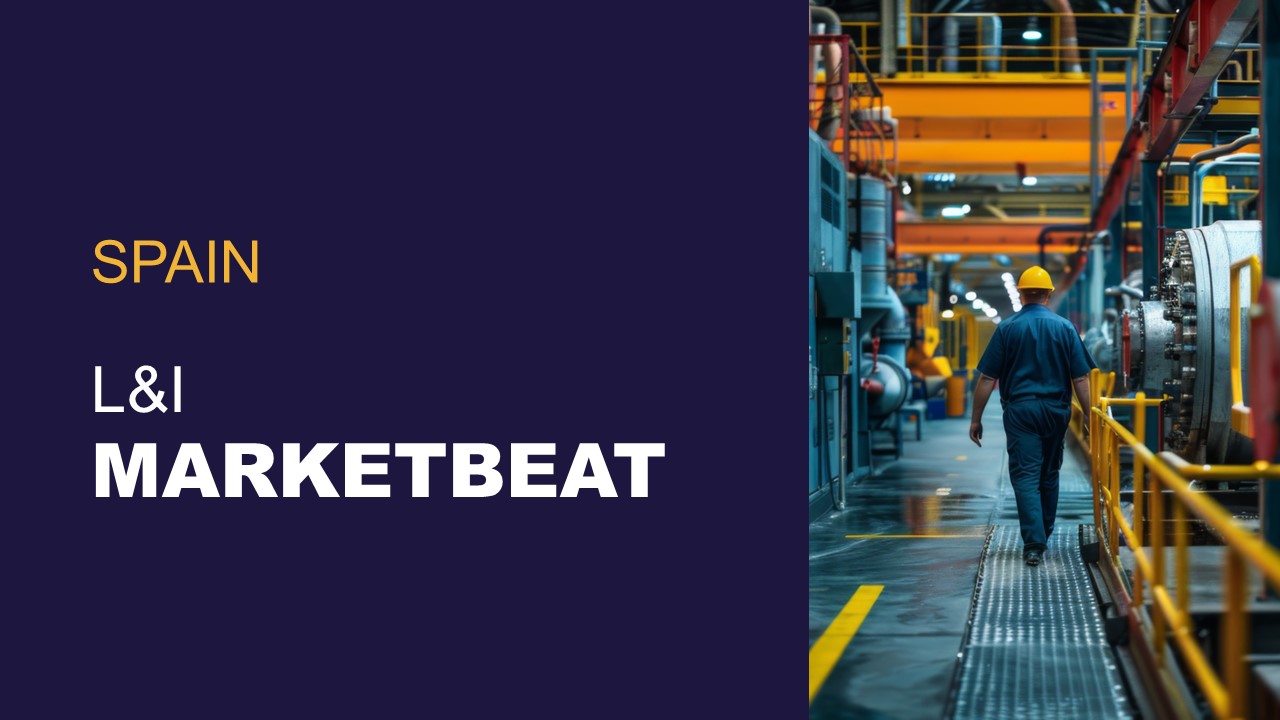

Insights
Strategic Sector Signals
Driven by major geopolitical and economic developments, governments across Europe are reshaping policies focused on defense, sustainability, and supply chain security. For industrial real estate, the implications are clear: demand for specialist industrial and logistics assets is set to accelerate.
Opportunities for Industrial Real Estate in Europe
As the EU and national governments implement ambitious strategies, demand for industrial and logistics real estate is set to increase significantly across key strategic sectors. New policies, including legally-binding targets for domestic procurement, are creating unprecedented opportunities and challenges.
Our latest report, "Strategic Sector Signals: Opportunities for Industrial Real Estate in Europe," offers a deep dive into the four sectors at the heart of this transformation: Defence, Clean Energy Technology, Critical Materials, and Life Sciences.
This comprehensive report explores the impact of these shifts on real estate, providing actionable insights for stakeholders across the value chain. Whether you are an occupier, investor, developer, or landlord, this report will equip you with the knowledge needed to navigate this evolving landscape.
STRATEGIC SECTORS IN SPAIN
Spain is strengthening its position across several strategic industries, playing a relevant role in the European industrial and technological ecosystem.
In the defence sector, Spain stands out for its production capacity—particularly in specialised components and systems—and is recognised as an established, though smaller, player in the global arms export map, behind countries like France or Germany.
In wind energy, Spain is a key manufacturing hub for blades and towers, with Bilbao acting as a strategic port for offshore operations and logistics.
The solar industry also sees domestic production at specific points along the value chain, although capacity remains limited compared to other European markets.
Spain is gaining traction in life sciences, with Barcelona (Biocat) and Madrid identified as growing R&D and pharmaceutical manufacturing clusters, supporting the sector’s expansion in Southern Europe.
Finally, in the emerging field of battery recycling, Spain benefits from facilities located close to battery production plants—supporting circular economy models and the future of sustainable mobility.
Download the full report External Link now to gain exclusive access to an in-depth analysis and strategic recommendations.
Defence

Increased Spending and Security Focus Driving Real Estate Demand
Following the invasion of Ukraine, Europe's focus on its defence and security capabilities has massively sharpened. New spending commitments by NATO members and EU initiatives like "Readiness 2030" are set to significantly increase demand for defence equipment and drive the need for manufacturing and logistics space across the continent.
Download the report to read moreKey Insights:
A massive uplift in defence spending is underway, with NATO members targeting 3.5% of GDP by 2035. Combined with new EU targets for procuring at least 50% of defence investments from within the EU by 2030, this is directly boosting demand for domestic manufacturing facilities.
Locational choices are driven by strategic factors, including proximity to military bases and specialised labour clusters. Investment is expanding in traditional hubs like the UK, France and Germany, while CEE countries, particularly Poland and Romania, are emerging as major defensive hubs.
Real estate demand spans the full spectrum, with 54% of new facilities created through expansions of existing sites, 16% by converting older buildings, and 26% from new builds. There is also a critical need for centralised logistics hubs and munitions depots, especially along Europe's eastern flank.
Real estate commitments will be a mix of owner-occupied space for specialised production and leased facilities for non-specialised manufacturing and logistics operations and rapidly growing businesses. All spaces will require enhanced security and safety measures.
Clean Energy Technology

Policy and Climate Goals Accelerating Manufacturing Investment
European nations are accelerating efforts to reduce reliance on fossil fuels and enhance energy security. This, alongside ambitious climate goals, has spurred massive investment in renewable energy infrastructure and the domestic manufacturing capability to support it, backed by policies like the EU's Net-Zero Industry Act (NZIA).
Download the report to read moreKey Insights:
EU and UK policies are creating enormous demand, with the NZIA setting a goal for European manufacturing to meet at least 40% of the EU's deployment needs by 2030. Government support includes financial incentives, faster permitting for strategic projects, and reduced energy costs.
The European wind power industry is a global leader but must scale up to meet targets, while solar PV manufacturing faces intense competition from lower-cost Chinese imports. Meanwhile, Small Modular Reactors (SMRs) represent a nascent but high-potential technology with European leaders emerging.
Manufacturing is concentrated in specialist clusters. Germany dominates both solar and wind capacity, with other key hubs for wind power in Denmark, Spain, and the UK's North Sea coast. Global SMR technology leaders include the UK and France with production likely be centred in regional hubs designed for off-site factory fabrication.
Real estate needs vary significantly by technology. Production of specialist components requires highly specialised buildings that are typically owner-occupied. In contrast, non-specialist component manufacturing and logistics operations can be accommodated in more conventional industrial buildings on either a leased or owned basis.
Critical Materials

Securing Supply Chains for the Green and Digital Transition
The transition to decarbonised and digital economies is driving explosive growth in demand for critical raw materials like lithium, cobalt, and rare earth elements. With global supply chains highly concentrated and vulnerable to disruption, Europe is now focused on building a resilient and competitive domestic supply chain through extraction, processing, and recycling.
Download the report to read moreKey Insights:
The EU's Critical Raw Materials Act (CRMA) sets clear 2030 targets to boost domestic capacity, aiming to source at least 10% of annual consumption from extraction, 40% from processing, and 25% from recycling within the bloc.
Growth in domestic supply will come from three key areas: mining, refining, and particularly recycling. Recycling of end-of-life products like EV batteries represents a huge opportunity, with estimates suggesting it could supply more than the expected demand for lithium, cobalt, and nickel for batteries by 2040.
Facility location is driven by function. Refining facilities are located near extraction sites or ports, while recycling plants are typically co-located with the manufacturing facilities they supply, such as EV battery recycling sites near gigafactories.
While real estate for mining and refining is specialised and owner-occupied, recycling facilities can often be housed in relatively standard industrial assets, creating opportunities for leasehold contracts and investment in modern industrial parks.
Life Sciences

Building Resilience and Competitiveness in a Post-Pandemic World
The COVID-19 pandemic highlighted the critical importance of secure supply chains for medicines and medical technologies, prompting governments to actively encourage and strengthen their domestic life sciences industries. Ambitious new strategies from the EU and UK aim to foster innovation, accelerate market access, and onshore critical manufacturing capabilities.
Download the report to read moreKey Insights:
The UK and EU have launched comprehensive sector plans to become global life sciences leaders, with initiatives including up to GBP 520 million in UK grants for manufacturing projects, fast-track planning for key sites, and support for R&D. The focus is on onshoring critical elements of the value chain to improve supply chain resilience.
The industry is heavily reliant on specialised clusters, often located near universities and research institutes, which benefit from government support and private investment. While traditional manufacturing hubs in Ireland, Germany and Switzerland remain strong, burgeoning areas include Warsaw and Rome.
Potential US trade tariffs on pharmaceuticals are a key uncertainty for European exporters, threatening to shift new investment towards the US. However, relocating highly regulated and expensive manufacturing operations is a significant undertaking that businesses will not take lightly.
Real estate requirements are for high-quality, specialised facilities. Production sites must comply with Good Manufacturing Practices and are often owner-occupied with long leases of around 15 years due to high fit-out costs. Logistics centres require Good Distribution Practice compliance, including cold storage, and are typically leased.
CONTACT US TO FIND OUT MORE
Access to Data
Solutions
Investor Focus
Let's Talk
CONTACT US FOR MORE INFORMATION
Insights

MarketBeat

Insights
Driven by major geopolitical and economic developments, governments across Europe are reshaping policies focused on defense, sustainability, and supply chain security. For industrial real estate, the implications are clear: demand for specialist industrial and logistics assets is set to accelerate.
Research
Waypoint: Global Industrial Dynamics 2025

Research
European City Logistics: Adapting to a Post-Pandemic World

Insights
The Most Disruptive Decade in Supply Chain History: Six Key Trends to Watch

Insights • Supply Chain
Transparency E-commerce & Logistics Q3 2022




